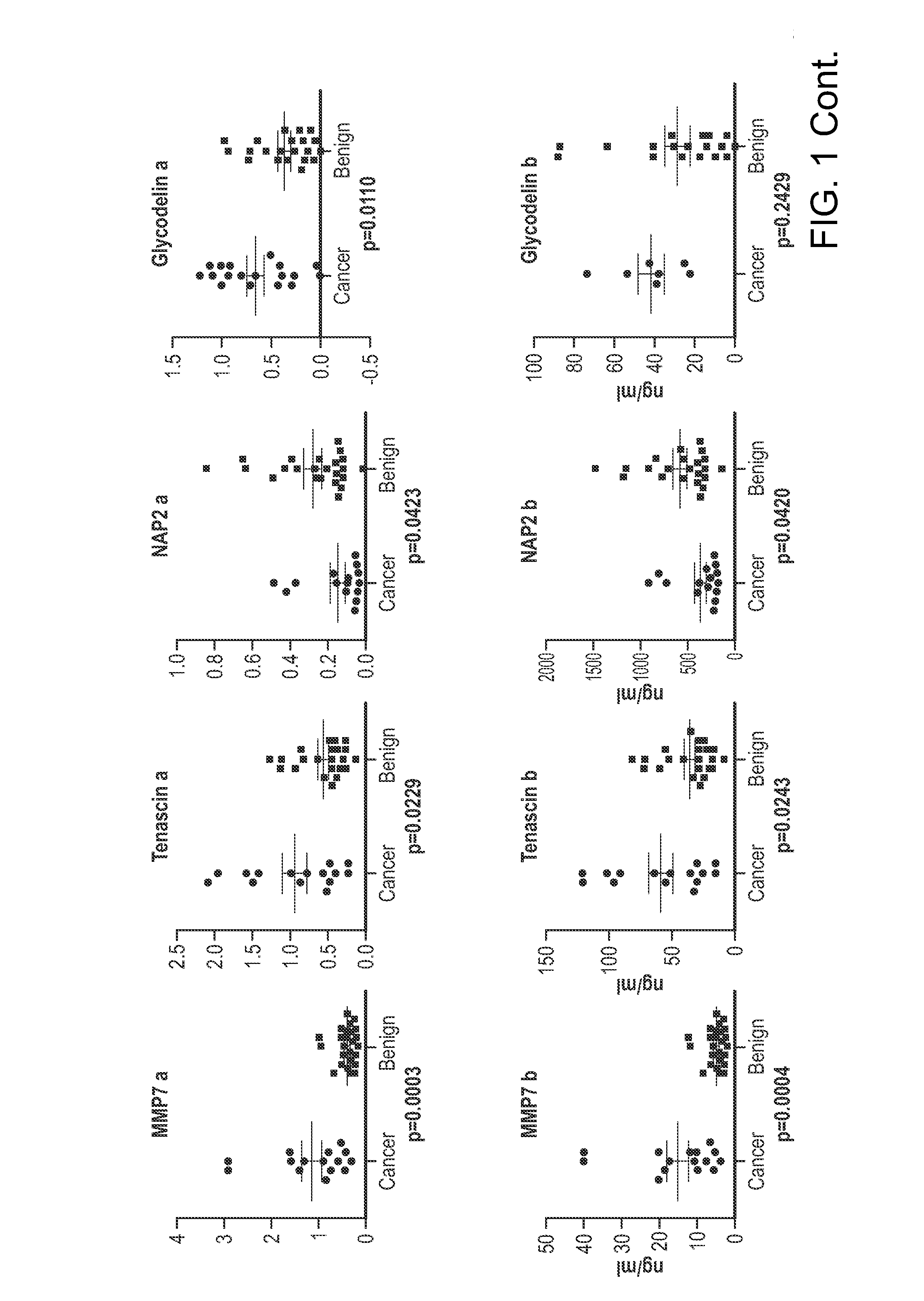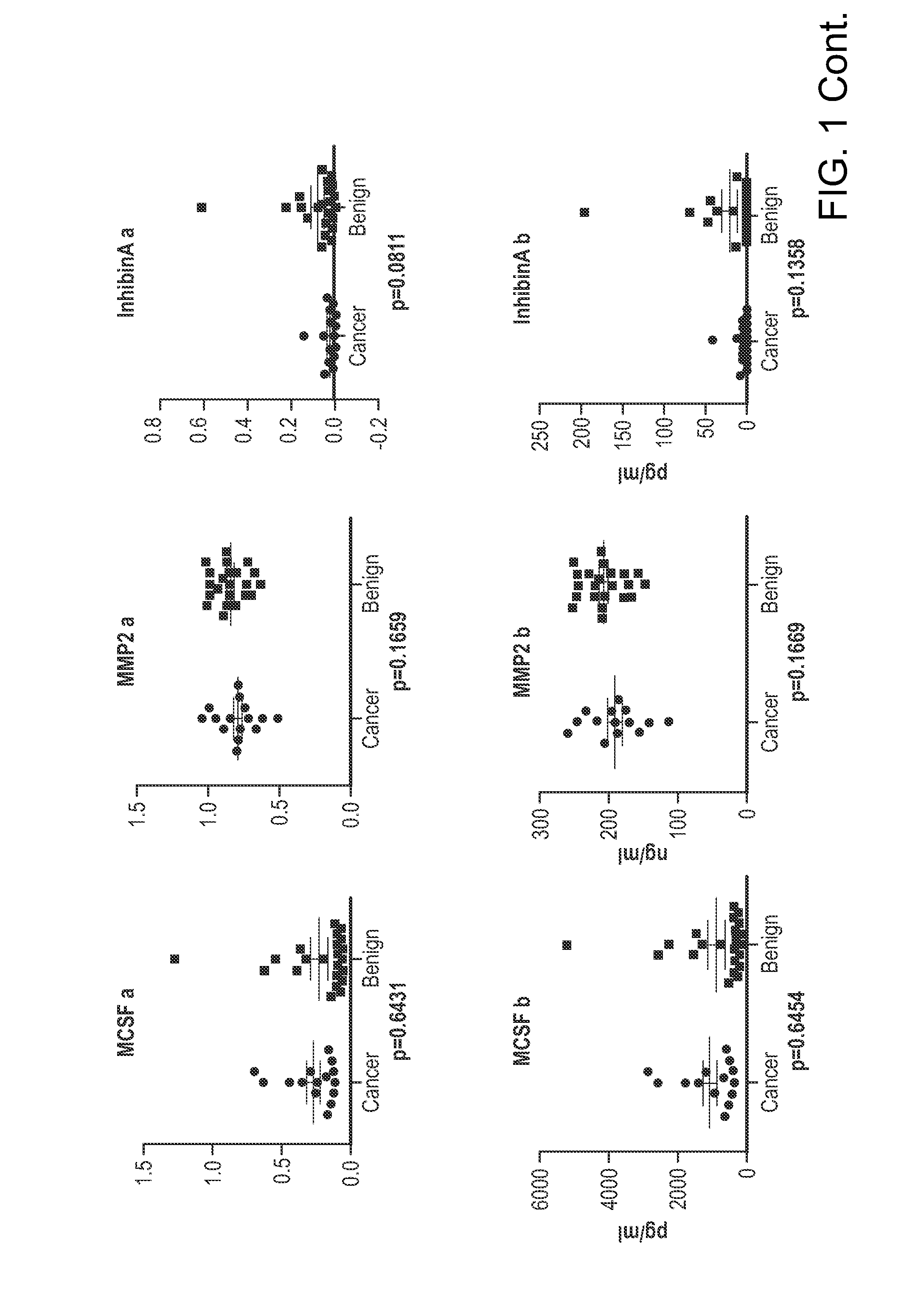Compositions and methods for diagnosing ovarian cancer
a technology of ovarian cancer and compositions, applied in the field of compositions and methods for diagnosing ovarian cancer, can solve the problem of extreme poor prognosis of such subjects
- Summary
- Abstract
- Description
- Claims
- Application Information
AI Technical Summary
Benefits of technology
Problems solved by technology
Method used
Image
Examples
example 1
Identification of a Panel of Biomarkers that Detect Ovarian Cancer
[0124]A panel of biomarkers was identified that provides a high level of specificity among women with benign pelvic masses while maintaining a high level of sensitivity in detection ovarian cancer. This panel of biomarkers includes: MMP9, tPA, IGFBP2, MMP7, Tenascin, NAP2, Glycodelin, MCSF, MMP2, InhibinA, uPAR, EGFR. Some of the biomarkers have been previously reported as associated with ovarian cancer. The current invention provides for the use of such markers not only for the detection of ovarian cancer, but also in distinguishing benign pelvic masses from ovarian cancer. In particular, the use of these biomarkers complements the use of CA125 to enhance the specificity of preoperative assessment of ovarian tumors as likely to be benign or malignant.
[0125]ELISA tests of biomarkers were performed on 15 ovarian cancer patients and 22 patients with benign pelvic masses. The biomarkers, MMP7, Tenascin C, NAP2, uPAR, and...
example 2
A Panel of Markers Useful in Distinguishing Malignant from Benign Ovarian Tumors
[0128]In other experiments, the following biomarkers: tPA, IGFBP2, MMP2, MMP7, MMP9, MCSF, Inhibin A, Glycodelin, Tenascin C, NAP2, uPAR, and EGFR were identified as having high specificity in preoperative assessment of ovarian tumor for risk of cancer among women with elevated CA125.
[0129]ELISA tests of 12 biomarkers were carried out on tPA, IGFBP2, MMP2, MMP7, MMP9, MCSF, Inhibin A, Glycodelin, Tenascin C, NAP2, uPAR, and EGFR. These biomarkers were selected based on their individual relevancy to ovarian cancer and their ability to be assayed by ELISA. ELISA analyses were performed on 15 ovarian cancer patients and 22 patients with benign pelvic masses and relatively high serum CA125 levels (mean=155.5 IU, median=101.6 IU). The biomarkers were first evaluated individually by ROC curve analysis. The selected biomarkers were further assessed by multivariate logistic regression for their significance in c...
example 3
IGFBP2 and MMP7 Distinguished Malignant from Benign Ovarian Tumors
[0133]In additional studies using the techniques described above, area-under-curve (AUC) from receiver operating characteristic (ROC) curve analysis demonstrated the discriminatory power of biomarkers individually and in combination in separating malignant from benign ovarian tumor on independent validation samples (n=222). In FIG. 3, IGFBP2 (Insulin-like growth factor-binding protein 2) is shown using a blue dot / dash line, AUC=0.7976. MMP7 (matrix metalloproteinase-7) is shown using a green dash line, AUC=0.7741. The two biomarkers are complementary as shown by ROC of a combination of the two markers through logistic regression, red solid line, AUC=0.8342.
PUM
| Property | Measurement | Unit |
|---|---|---|
| Molar density | aaaaa | aaaaa |
Abstract
Description
Claims
Application Information
 Login to View More
Login to View More - R&D
- Intellectual Property
- Life Sciences
- Materials
- Tech Scout
- Unparalleled Data Quality
- Higher Quality Content
- 60% Fewer Hallucinations
Browse by: Latest US Patents, China's latest patents, Technical Efficacy Thesaurus, Application Domain, Technology Topic, Popular Technical Reports.
© 2025 PatSnap. All rights reserved.Legal|Privacy policy|Modern Slavery Act Transparency Statement|Sitemap|About US| Contact US: help@patsnap.com



